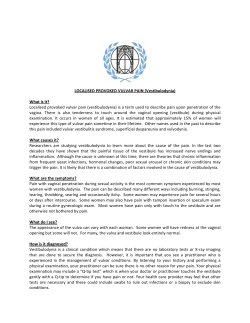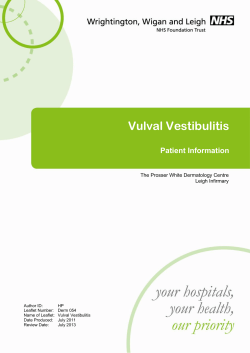
Vestibulitis/Vestibulodynia General Definitions:
Vestibulitis/Vestibulodynia General Definitions: Dyspareunia- Difficult or painful sexual penetration in women Vulvar vestibulitis- also termed vestibulodynia and localized vulvodynia: A chronic clinical syndrome characterized by: 1) severe pain on vestibular touch or attempted vaginal entry, 2) tenderness to pressure localized within the vulvar vestibule, and 3) physical findings of redness of various degrees. Another attribute: usually no pain unless touched, so you may see “provoked localized vulvodynia.” This is felt to be a localized skin problem Vulvodynia- this is a general term. As defined by the International Society for the Study of Vulvar Disease it is: chronic vulvar discomfort, especially that characterized by the patient's complaint of burning, stinging, irritation or rawness. This is the general name used for chronic vulvar pain. Essential vulvodynia- also termed generalized vulvodynia: a condition in patients who lack significant changes on physical examination but complain of constant burning sensations in the vulva. This is thought to be a nerve disorder. Pelvic floor myalgia- Tight and painful muscles in the pelvis around the vagina make intercourse painful. This can be called vaginismus, but it is better to speak of myalgia, because historically vaginismus became thought of as a neurosis. It can feel like a “blockage” or “wall” inside. This tightness can result in a smaller vaginal opening and cause little splits in the skin there during intercourse. Muscles that spasm can develop a burning feeling. Confusing names: vulvodynia is a general term and is also a specific diagnosis. The names keep changing. What is the nature of the vulvar vestibule? And where is it? It is the entryway to the vagina. It is the skin from inside the small lips over to the hymen. It is skin from the clitoris to the back of the vaginal opening. It originates in the embryonic layer that is called endoderm from which the bladder was formed. Next to it on the inside is the tissue of the vagina that arose from the mesoderm, and on the other side are the labia that arose from the ectoderm. Each has its nature and different sensitivity. Therefore there is a unique narrow portion of skin that forms the entryway to the vagina and it has a capacity to develop exquisite tenderness, i.e., vulvar vestibulitis. Primary and Secondary Vestibulodynia: Those who have always had tenderness since they first tried to use tampons or first tried intercourse are considered to have primary vulvar vestibulodynia (VV). Secondary VV is the term for those who were without pain or tenderness initially but later developed vestibulodynia. Bad bladder infections or episodes of bad vaginitis can precede some of these cases. Experts have argued about whether a cause of secondary The Program in Vulvar Health • OHSU Center for Women’s Health Last updated May 2011 • www.ohsuwomenshealth.com/vulva/ vestibulodynia is human papilloma virus (HPV), but it may act as a “hit and run” agent, as there is rarely evidence of the virus at biopsy years later. Topical chemical irritants can switch on the inflammation of vestibulodynia. An example is 5-FU cream, which was used for HPV. Some clinicians are suspicious that yeast (candida) or treatment agents for candida are to blame, but episodes and treatments are so common that cause and effect are hard to prove. History: Textbooks of gynecology one hundred years ago described and offered treatments for what we now realize was vulvar vestibulodynia. The original term was vaginismus. They described both skin pain and muscle tightness together. The skin aspect dropped out of the writings by the 1930s, presumably with the increasing interest in psychosomatic theories of pain. Vaginismus is actually a psychiatric diagnosis related to aversion to penetration, not mentioning pain. Our modern references to vestibulitis began appearing in 1985. Postpartum vestibulitis: Over one third of women delivering babies may develop vestibulodynia as a reaction to hormonal changes of delivery and lactation. This may be mild, moderate or severe and may last an average of six months. It is temporary due to lack of estrogen, although in a few it does not resolve with the return of periods. Menopausal pain with sex: This is commonly called vaginal dryness. However, the use of lubricants does not change the sensation, indicating that it really is not dryness that causes the pain. It is incorrectly assumed that it is vaginal pain from thinning. It is true that the vaginal skin thins and gets red or pale due to lack of estrogen. But the area of the pain or dryness is the vestibule, not the vagina, as the vagina has fewer nerve endings. Sometimes worse than the surface tenderness is the pain from muscles around the vagina which tighten as a reaction and become painful too. Menopausal vestibulitis is related to loss of estrogen, but not all women develop it in menopause. It usually reverses with estrogen therapy. Theories to Explain Findings: Vulvar vestibulodynia is a problem of too many skin nerves in small zones. Use of topical lidocaine liquid for several minutes reverses the pain, so it is very superficial pain. Theories include increased local inflammation factors like histamines and substance P, which keep the capillaries dilated and increase the nerve endings. Another theory is that estrogen receptors disappear and this somehow signals the extra nerves to grow. Only in menopause is estrogen therapy really helpful, as younger women have estrogen, but the tissues cannot sense it. Problems to rule out: Low-grade infection of the vulvar skin will hurt in the vestibule. Mild yeast infections and group B Strep vaginitis should have been ruled out to have a diagnosis of vulvar vestibulodynia. Pelvic floor muscle dysfunction can be a source of pain. This results from prolonged protective contracting of pelvic floor muscles as a response to vulvar pain with or without touch. The Program in Vulvar Health • OHSU Center for Women’s Health Last updated May 2011 • www.ohsuwomenshealth.com/vulva/ This is vaginismus. The tight muscles are tender themselves when pushed on with intercourse or exams. Vulvar pain syndromes do not pre-dispose to cancer and they are not contagious. Therapies for Vulvar Pain: Many pill and cream therapies have been tried for vulvar vestibulitis but do not have a high rate of success. These include cortisone creams, hormone creams, anti-herpes therapies, antifungals, topical use of hot red pepper extract (capsaicin), injections of steroids, and therapies used for shingles. The one helpful therapy for symptom relief is topical liquid lidocaine applied just before intercourse. This, plus use of an effective lubricant, can help many who have mild and even moderate vestibulitis. With the temporary absence of the skin pain they can learn to relax their pelvic floor muscles, thereby further reducing their discomfort. A therapy of calcium citrate supplements in conjunction with restrictions of acid foods has had variable success in treating generalized pain. The calcium therapy is not harmful. Extreme adherence to the low oxalate diet, however, can be problematic as regards healthy nutrition. Injections of interferon have only a 50% chance of improving vestibulitis and can be considered if there is suspicion of recent HPV. This is not used very often. Physical therapy helps the muscle pain that is so often associated with vulvar pain. The therapist must be trained in pelvic floor muscle work. Soft or firm vaginal dilators of varying sizes can be helpful for home use so that you can tell when relaxation succeeds enough to allow the next larger size to pass easily. Biofeedback with a vaginal sensor can also be very helpful. Finding the right physical therapist for you is vital to your therapy and journey towards improvement. If a physical therapist is not specifically recommended to you by your vulvar provider, these websites can be explored to find a therapist in your city or region. http://www.apta.org/ http://wwww.womenshealthapta.org/ Surgery has the best results for vulvar vestibulodynia, and this has been shown in more than 20 reports. We offer a procedure that we developed that is very superficial. It is done after complete numbing and just removes the surface tenderness, using the hymen flap to cover the small area where involved skin surface was removed. It is done in day surgery or in the office with local anesthesia. Our cure rate is 85%. Usually physical therapy is necessary after surgery. Professional counseling is important for patients and their partners. Sex therapists are specialists in this area and can help with the complicated emotions and difficult communication that is so common with these pain problems. The Program in Vulvar Health • OHSU Center for Women’s Health Last updated May 2011 • www.ohsuwomenshealth.com/vulva/ Combined Problems: Patients present with combinations of the problems discussed above. Pelvic muscle tension or spasm should be assumed to exist and needs therapy in women who have had years of vulvodynia or dyspareunia from vestibulitis. The question is which therapy to provide first. • There are women who have only mild vestibulitis on examination and muscle tightness is their overriding problem. In these women physical therapy should be the first therapy tried. • Some women have such focal severe vestibulitis that physical therapy cannot succeed due to skin pain. Surgery or laser should then be done first before embarking on physical therapy for the remaining vaginismus component. • Surgery sometimes improves the situation but leaves tiny remaining areas of sensitive vestibule. These may need later small office biopsies. • Topical lidocaine should become a familiar tool of the physical therapist and patient to allow painless touch of the vestibule during trigger point work and use of the vaginal dilators. Conclusion: Vulvar pain is complicated. It has a long history but has also been re-discovered. It combines old theories of pain with new ones. It touches many professions including neurology, gynecology, psychology, physical therapy, urology and pharmacology. Patients usually need the combined help of several specialties. References: 1. Bergeron S, et al, A randomized comparison of group cognitive-behavioral therapy, surface electromyographic biofeedback, and vestibulectomy in the treatment of dyspareunia resulting from vulvar vestibulitis, Pain. 91:297-306 2. Goetsch M, Vulvar Vestibulitis: Prevalence and Historic Features in a General Gynecologic Practice Population. Am J Obstet Gyn. 164:1609-16,1991. 3. Goetsch M, Simplified Surgical Revision of the Vulvar Vestibule for Vulvar Vestibulitis. Am J Obstet Gyn. 174:1701-07,1996. 4. Goetsch M., Postpartum Dyspareunia-An Unexplored Problem, Journal of Reproductive Medicine, 44;963-8, December, 1999. 5. Reissing E, Minik Y, et al, Vaginal Spasm, Pain and Behavior: An Empirical Investigation of the Diagnosis of Vaginismus. Archives of Sexual Behavior. 33:5-17, 2004. 6. Zolnoun, Overnight 5% Lidocaine Ointment for Treatment of Vulvar Vestibulitis. ObstetGynec 102(1):84-7, 2003 7. Goetsch, “Vulvar Vestibulitis: Dual sources of pain?” National Vulvodynia Association Newsletter, Winter 05. 8. Romm J and Jensen J; “Incidence of Vaginismus in Patients Evaluated in Vulvar Pain Clinic”, (Abstract) Women’s Health Journal; 5:4:239-240; Winter 1995. 9. Leclair CM, Goetsch MF, Lee KK, Jensen JT. KTP-Nd: YAG Laser Therapy for the Treatment of Vestibulodynia: A Follow-Up Study. J Reprod Med 2007;52:53-58. 10. Goetsch M, Observations Combined with Muscle Therapy for Dyspareunia from Vulvar Vestibulitis, J Reprod Med 2007;52:597-603. 11. Goetsch M, Patients’ Assessments of a Superficial Modified Vestibulectomy for Vestibulodynia. Presented at ISSVD and submitted to JRM July 2007; in press. The Program in Vulvar Health • OHSU Center for Women’s Health Last updated May 2011 • www.ohsuwomenshealth.com/vulva/
© Copyright 2025














